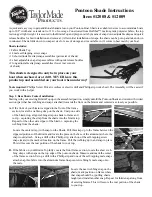
GE M
EDICAL
S
YSTEMS
- K
RETZTECHNIK
RAFT
V
OLUSON
® 730P
RO
/ 730P
RO
V (BT´04)
D
IRECTION
KTI105947, R
EVISION
2
S
ERVICE
M
ANUAL
5-6
Section 5-2 - General Information
Section 5-2 General Information
(cont’d)
Signal flow travels from the Probe Connector Panel to the Front End Electronics, to the Back-End
Processor, and finally displayed on the monitor and peripherals.
For more detailed explanations of functions and controls refer to the Voluson® 730Pro / 730ProV Basic
User Manual.
5-2-1
Description of Voluson® 730Pro / 730ProV Operating Modes
5-2-1-1
B-Mode or 2D-Mode
B-Mode or 2D-mode is a two-dimensional image of the amplitude of the echo signal. It is used for
location and measurement of anatomical structures and for spatial orientation during operation of other
modes. In 2D-mode, a two-dimensional cross-section of a three-dimensional soft tissue structure such
as the heart is displayed in real time. Ultrasound echoes of different intensities are mapped to different
gray scale or color values in the display. The outline of the 2D cross-section may be a rectangle,
parallelogram, sector or 360-degree circle, depending on the particular transducer used.
2D-mode can be used in combination with any other mode.
5-2-1-1-1
Coded Harmonic Imaging (HI)
In Harmonic Imaging, acoustic aberrations due to tissue are minimized by receiving and processing
the second harmonic signal that is generated within the insonified tissue. Voluson® 730Pro /
730ProV`s high performance HI provides superb detail resolution and penetration, outstanding
contrast resolution, excellent acoustic clutter rejection and an easy to operate user interface.
Coded Harmonics enhances near field resolution for improved small parts imaging as well as far
field penetration. It diminishes low frequency amplitude noise and improves imaging technically
difficult patients. It may be especially beneficial when imaging isoechoic lesions in shallow-depth
anatomy in the breast, liver and hard-to-visualize fetal anatomy.
Coded Harmonics may improve the B-Mode image quality without introducing a contrast agent.
5-2-1-2
M-Mode
In M-mode, soft tissue structure is presented as scrolling display, with depth on the Y-axis and time on
the X-axis. It is used primarily for cardiac measurements such as value timing on septal wall thickness
when accurate timing information is required. M-mode is also known as T-M mode or time-motion mode.
Ultrasound echoes of different intensities are mapped to different gray scale values in the display.
M-mode displays time motion information of the ultrasound data derived from a stationary beam.
Depth is arranged along the vertical axis with time along the horizontal axis. M-mode is normally used
in conjunction with a 2D image for spatial reference. The 2D image has a graphical line (M-line)
superimposed on the 2D image indicating where the M-mode beam is located.
5-2-1-2-1
MCFM Mode (M Mode + Color Flow Mode)
Color Flow Mode and Color M Mode are Doppler modes intended to add color-coded qualitative
information concerning the relative velocity and direction of fluid motion within the 2D mode or M
mode image. Color Flow overlays color on the M mode trace using velocity and variance color
maps. The Color Flow wedge overlays the 2D mode image and M mode timeline.
















































